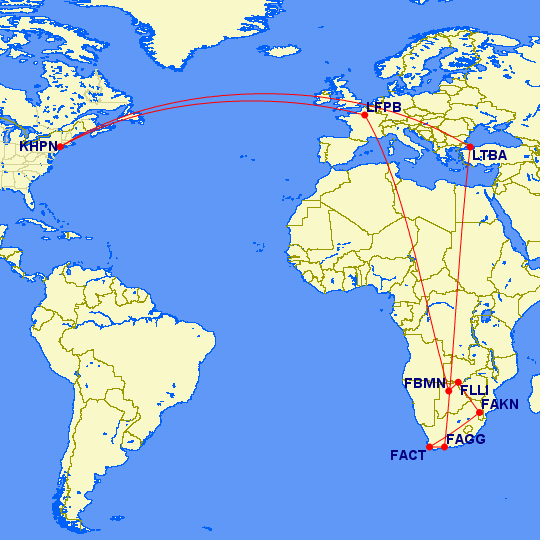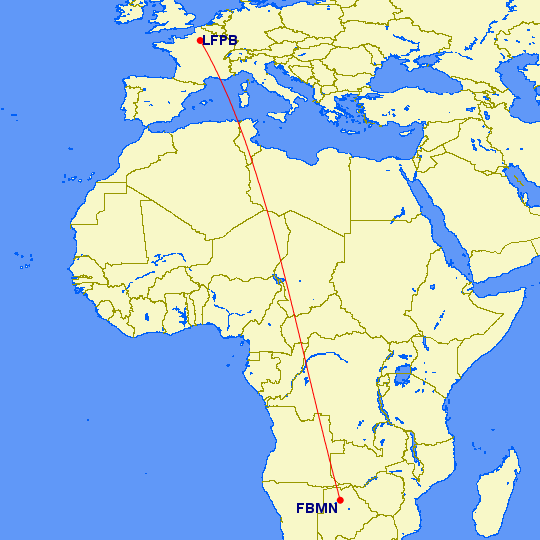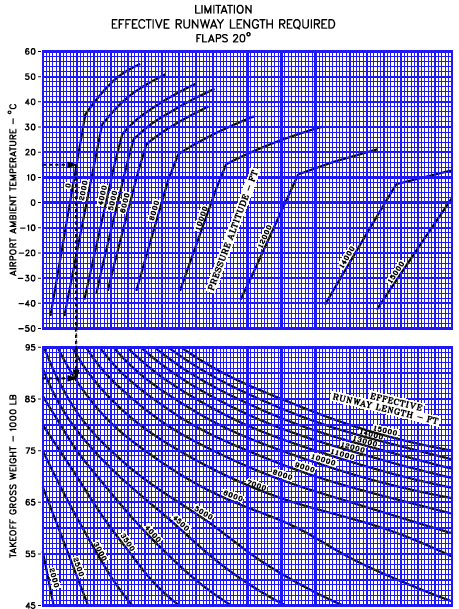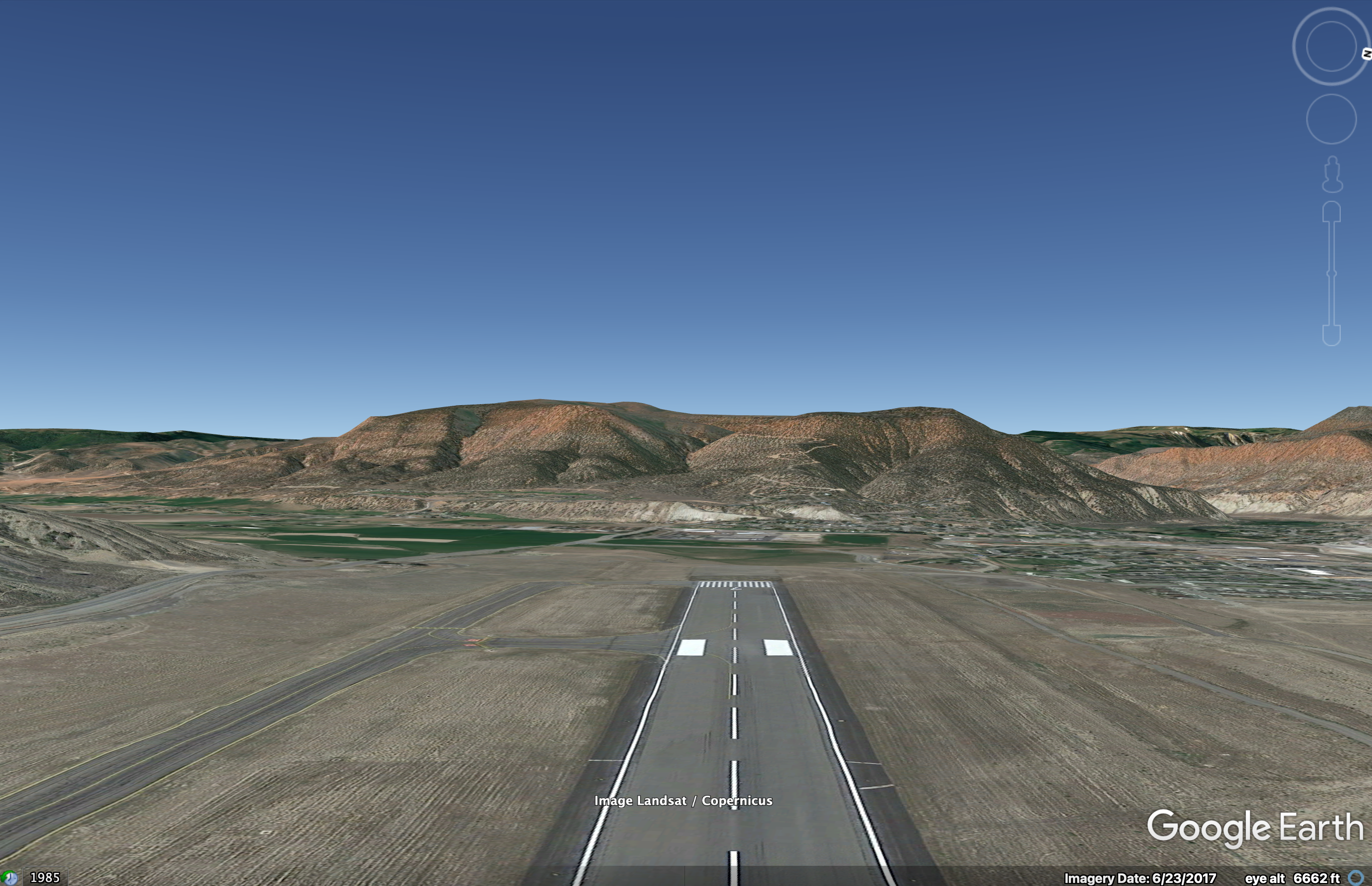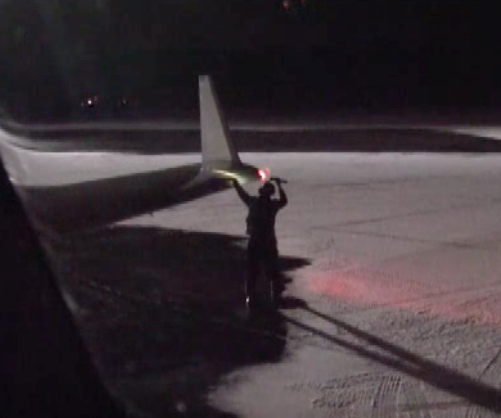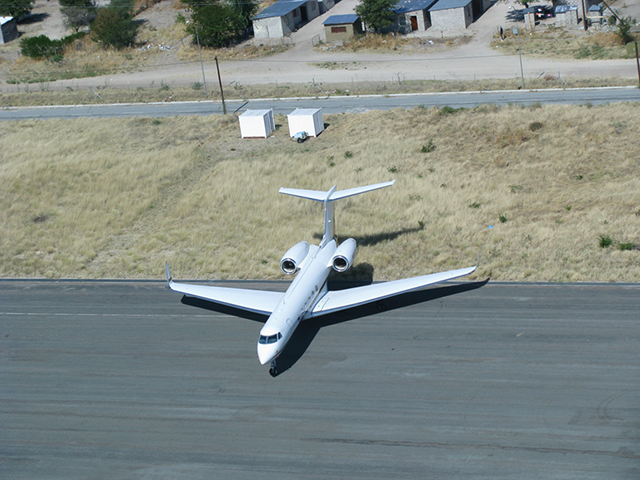How do you know an airport can support your aircraft? We often get asked that question and somehow muddle through an answer. But we always have that nagging doubt: did I forget something?
— James Albright

Updated:
2021-09-19
What follows is a walk through of the process I use. As an example, I'll use a charter trip I flew on a GV a few years ago. The itinerary came down as: KHPN - LTBA - FAGG - FACT - FAKN - FLLI - FBMN - LFPB - KHPN. NetJets decided the trip was okay. None of the legs was longer than 13 hours, well within the airplane's capability and we would have an additional pilot for all legs over 10 hours. All of the airports, they knew, had at one point or another supported a GV. No problem, right? I was familiar with each airport except one, FBMN, and that is where I put my focus. Here goes . . .
1 — Is the runway long and wide enough?
2 — Can the runways, taxiways, and ramps support the weight of the aircraft?
3 — Does the airport have instrument capability and will this be necessary?
4 — Does the weather indicate de-ice/anti-ice will be necessary and if so, is it available?
Will this process catch everything? No, but it gets you started. If the airport passes all these tests it is a good idea to "chair fly" the mission. Imagine yourself going through arrival, approach, landing, shut down, aircraft securing, start up, fueling, taxi, takeoff, departure; all of it. Look for anything that can go wrong. And remember something will go wrong, it is just a matter of stacking the odds in your favor so you can recover gracefully.

1
Is the runway long and wide enough?
This is where I begin, only because it is the easiest way to disqualify an airport and if it fails this step, you don't have to bother with the rest of it. So that begs the questions, how long is long enough and how wide is wide enough?
The airport diagram is a great place to start, but remember to check the NOTAMs. It would be pretty embarrassing to arrive at an airport where the only suitable runway had been closed for repairs for several weeks.
Runway length
If your operation has hard and fast rules about this, it is simply a matter of doing the math. If you don't have iron clad rules, then it is a matter of getting into the books. There are no legal minimums for runway length, only that you can safely land and then takeoff again. The takeoff must consider a failure of the critical engine.
I find it helpful to know what the airplane can do under optimal conditions. If the runway is shorter than that, the airport is not qualified and you look for another. If the answer is close, you need to break out the books and make sure that particular runway is long enough for the conditions you expect.
In the case of our GV, the shortest possible runway with the very lightest GV, on a cold day, sea level pressure altitude, everything working; the best the airplane can do is land in 2,200'. So we know that's our absolute minimum. The example airport runway, Maun, Botswana, is long enough. (The G450's absolute minimum is 3,000'.)
Takeoff performance numbers can be more restrictive than landing numbers unless conditions are ideal. You need to have minimum numbers in mind here too.
Source:
In the case of our GV, the shortest possible runway with the very lightest GV, on a cold day, sea level pressure altitude, everything working; the best the airplane can do is takeoff in 2,200'. So we know that's our absolute minimum. The example airport runway, Maun, Botswana, is long enough. (The G450's absolute minimum is 2,500'.)
Runway width
There isn't a published minimum runway width, per se, but there is a minimum runway width:
VMCG, the minimum control speed on the ground, is the calibrated airspeed during the takeoff run at which, when the critical engine is suddenly made inoperative, it is possible to maintain control of the airplane using the rudder control alone (without the use of nosewheel steering), as limited by 150 pounds of force, and the lateral control to the extent of keeping the wings level to enable the takeoff to be safely continued using normal piloting skill. In the determination of VMCG, assuming that the path of the airplane accelerating with all engines operating is along the centerline of the runway, its path from the point at which the critical engine is made inoperative to the point at which recovery to a direction parallel to the centerline is completed may not deviate more than 30 feet laterally from the centerline at any point. VMCG must be established with—
(1) The airplane in each takeoff configuration or, at the option of the applicant, in the most critical takeoff configuration;
(2) Maximum available takeoff power or thrust on the operating engines;
(3) The most unfavorable center of gravity;
(4) The airplane trimmed for takeoff; and
(5) The most unfavorable weight in the range of takeoff weights.
Source: 14 CFR 25.149 (e)
So you are saying Part 25 is the regulation for certifying the airplane not for flying the airplane. I am saying that I am not going to operate the airplane in conditions it wasn't certified to operate. If you are with me on that, then the minimum runway width is the width of the main gear plus 30' to the left and 30' to the right.
In a GV that comes to: 30' + 14'4" + 30' ≈ 75'. (The G450's number is the same.) The example airport runway, Maun, Botswana, is wide enough.
2
Can the runways, taxiways, and ramps support the weight of the aircraft?
Aircraft Classification Number (ACN)
You need to know how much force the airplane exerts on the surface when it is standing still, and you need to know that for the range of expected weights and for every surface you expect to land, taxi, park, and later takeoff. This number is known as the Aircraft Classification Number (ACN) and varies for the surface type, the weight of the aircraft, and the tire pressure. Then you need to compare this to what the particular surfaces have to offer, known as Pavement Classification Number (PCN). More about this: ACN versus PCN.
I long ago made the decision I would not vary tire pressure to do this, so my decision is based on a single chart in the GV manual suite, found in the Quick Reference Handbook. The GV ACN never gets smaller than 12 for a ridiculously light aircraft, or 26 for a GV at maximum weight. (For a G450 the range is from 11 to 27.)
Runway Pavement Classification Number (PCN)
* Note: the airport runway has since been resurfaced and the ACN raised substantially (44 in 2016)
If you are lucky, the airport directory will have the PCN for the runway. If the PCN is lower than the light weight aircraft number, the surface does not qualify and you need to look for another airport. If the number is greater than the maximum weight number, that surface is good enough. In between? More research is needed.
In the case of our example airport back in 2007, the numbers are provided for the runway in the Jeppesen Airport Directory as 18/F/B/X/T. That means an 18 on flexible pavement of medium subgrade strength. Looking at the chart, the low number is 12 and the high is 27. The aircraft can operate on this runway when the gross weight is 65,000 lbs or less. Our aircraft would weigh 50,000 lbs with passengers, baggage and no fuel. We could load 15,000 lbs of fuel for this runway. Based on this, I told NetJets we could land at Maun but we could not takeoff and fly a trip longer than 3 hours in ideal weather conditions and have suitable IFR reserves. The flight from Maun to Paris was out of the question. We could fly into and out of Maun, but not with more than 15,000 lbs of fuel.
Taxiways and Ramp Areas
Even if the runway PCN is sufficient, you still need to consider taxiways and ramps. You will rarely see numbers for these published. If you know aircraft with higher ACN numbers operate on these surfaces, you are probably okay to go. Otherwise, you need to call the airport.
In the case of our example airport, Maun, Botswana, I got our English speaking handler to call the airport manager. The airport confirmed that they routinely had Boeing 737-100's operate on all taxiways and ramp areas that we could expect. Another few phone calls revealed a Boeing 737-100 has an ACN of 23 at its lightest weight. So I considered the taxiways and ramps good enough for a GV with no more than 15,000 lbs of fuel.
More about ACN and PCN
A lot of pilots transitioning from scheduled operations where they are not the first to fly to an airport don't worry about this at all. In the corporate aviation world you need to worry about it. You will be surprised to find out where your best intel is. I like to look at http://www.youtube.com/ where you can type in the name of the airport and see videos of takeoffs and landings.
If you do this for Maun, you will see a Boeing 737 land there. I've also seen airports showing Gulfstreams taxiing to their parking spots. There you have video proof that someone has gone there before you.
3
Does the airport have instrument capability and will this be necessary?
The next step, provided all the previous conditions have been met, is to consider the weather and instrument capability. Unless the weather is virtually guaranteed CAVU for your time of arrival, you should make sure the airport has an instrument arrival you can use. You cannot rely on GPS approaches worldwide, see GPS ICAO Rules and RNAV(GNSS) Example for more about this.
It's not enough to have the ability to get yourself to instrument minimums. What happens if you see what you need to continue beyond the DA, say on an ILS or EVS approach, and then have to balk the landing? Will your missed approach procedure keep you out of the dirt? It isn't as easy as you might think. More about this: Balked Landings.
As part of the instrument capability you should consider lighting. Our operations manual requires the runway be illuminated at night. I think yours should too, but I don't get a vote on your operation.
In the example case of Maun, Botswana, the available instrument approaches were adequate for the weather and compatible with our aircraft. The runway lighting was suspect, but we were operating there only during daylight hours.
4
Does the weather indicate de-ice/anti-ice will be necessary and if so, is it available?
If you expect icing conditions, you should make sure the airport can support you with hangar space and anti-ice / de-ice equipment suitable to your aircraft. When I was an Air Force squadron commander I had a crew stranded in Russia when the de-ice crew showed up in the form of a guy with a bucket of glycol and a sponge. You need to make sure they have a truck tall enough for your tail and you should make sure the truck is operational and they have enough of the right kind of fluid for your aircraft.
In the example case of Maun, Botswana, there was no chance of needing anti-ice / de-ice capability.
5
Other concerns
Are there diplomatic issues that will be show stoppers?
Flying internationally you have a host of other concerns, such as diplomatic clearances, insurance, cabotage, and special documentation just to name a few. See the International Operations Manual for more on this.
In the example case of Maun, Botswana, we had a lot to contend with, but each was dealt with by our handler.
Are there security concerns?
Depending on your operation, you may require armed security on the ramp or at least a ramp with 24/7 security. Lacking this, you can hire local security or bring your own. Or you may decide the airport cannot support you and choose another.
In the example case of Maun, Botswana, our local handler assured us the on-airport security was sufficient. (We decided, however, to not overnight the aircraft in another stop, Livingstone, Zambia, because of the security situation.)
How is the FBO or other ground support, will they be show stoppers?
Other issues, from the available limo service to catering, can impact your decision to use an airport or not. When given a choice, we routinely select London Luton over London Stansted because the former has a Gulfstream Service Center.
In the example case of Maun, Botswana, our handler had set up in country just for us and was on site for the duration.
What is the airport's fire rescue capability, are there suitable alternatives?
You should know the Aircraft Rescue Fire code for your aircraft should you need a tie breaker between two airports that are otherwise equally matched. If the airport's code is below your requirement, you should at least know what kind of fire coverage they have should you need it. I've never turned down an airport without an adequate ARFF code, or heard of anyone who has. But it could be a tie breaker between otherwise equal airports.
The GV has an FAA ARFF code of "B" and an ICAO code of "6" which is higher than the "4" available at our example airport, Maun, Botswana. (The numbers for a G450 are "A" and "5") I did not deem this sufficient for turning down the airport. Our GV was based out of Nashua, NH with a code of zero, no fire department on the airport.
6
Example conclusion
I told NetJets I could not fly the trip as published since the Maun, Botswana ramps, taxiways, and runway could not support the weight of our airplane with enough fuel to make it to Paris from Maun. The airport would be okay only provided the next leg was three hours or shorter. They rearranged the trip so that we would fly a short hop to Kruger, South Africa from Maun and to Paris after that. Problem solved.
We flew to Maun where the passengers surprised us with three tickets to a safari. We boarded a Cessna 206 and flew off. I took the picture of our GV, the biggest airplane on the ramp, right after takeoff to our great adventure.
(You can read about that silliness, if you like, here: On Safari in Botswana.)
